


The States have approved a new policy to maintain the size of the workforce by encouraging a higher level of inward migration into the island.
The new strategic population policy assumes that net inward migration – the number arriving in the island minus the number leaving – will now average 300 people per year. It has averaged only 100 a year for the past 12 years.
The policy change, put forward by the Committee for Home Affairs, was backed yesterday by 22 deputies with only nine voting against. However, seven deputies – nearly one in five – was absent for the key vote.
The Committee for Home Affairs estimates that its plan to treble net inward migration would maintain the working-age population at around 31,000 and increase the total population by approximately 4,000 to around 68,000 by the year 2051.
Deputies earlier rejected an alternative policy proposed by Deputy Peter Roffey, who wanted to aim for smaller increases in inward migration and no population growth in the long term alongside raising productivity in the local workforce.
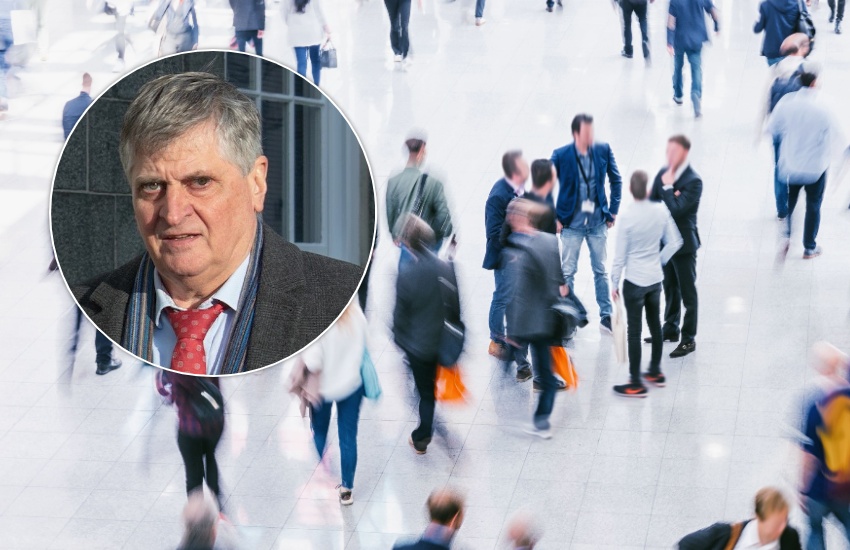
Pictured: Deputy Rob Prow's Committee for Home Affairs yesterday secured unprecedented backing from the States for policies to increase inward migration into the island which are projected to take the population to around 68,000.
The Committee’s President, Deputy Rob Prow, told the States that the new +300 migration policy will be “an assumption that we need to use to see what we need to do in the future…not a target or an aim”.
In the policy letter explaining its proposals, the Committee said: "The States will assume, for the purpose of planning future infrastructure and service provision, that net migration will average up to 300 per year over the next 30 years. This assumption will support the capacity of the island’s workforce so that it remains a desirable and competitive jurisdiction and will ensure that the island can meet the needs of the economy with the necessary housing and infrastructure.
"The revised strategic population objective is neither a target nor a cap. Nor is it the mechanism which automatically increases Guernsey’s working population, not least as Guernsey’s working population level is subject to myriad external factors. Instead, it is an assumption based on analysis undertaken to evaluate what the Guernsey economy will need to remain competitive.
"It does not seek to list who the island needs, when it needs them, and which year that they need to arrive. What it does do is set out, at a high level, the framework in which government will need to consider its population in the next 10-30 years, not least to ensure appropriate planning can be taken in respect of housing and planning, the provision of public services, investment in infrastructure and maintaining fiscal balance."
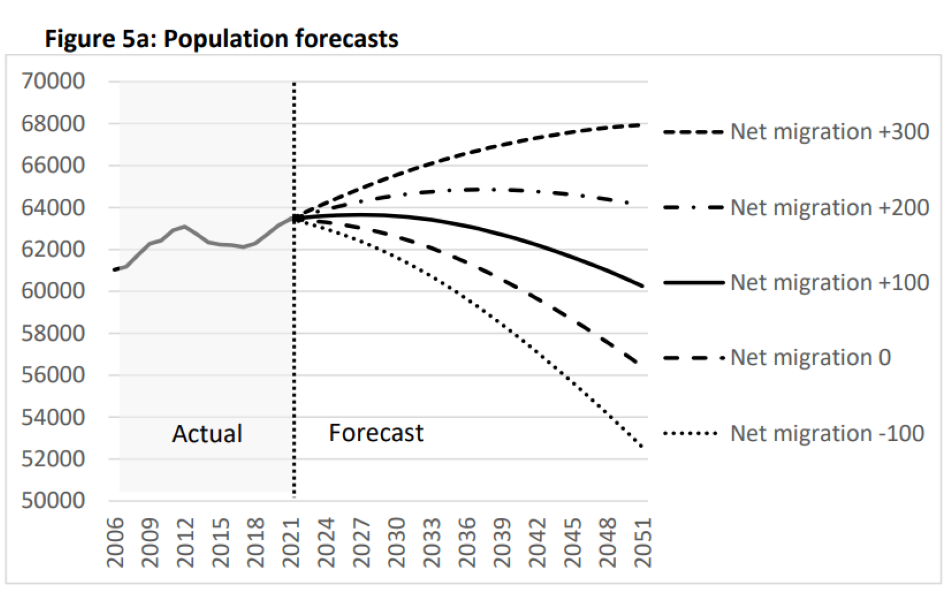
Pictured: This chart, published by the Committee, indicates how different levels of net inward migration alter the total size of the island's population.
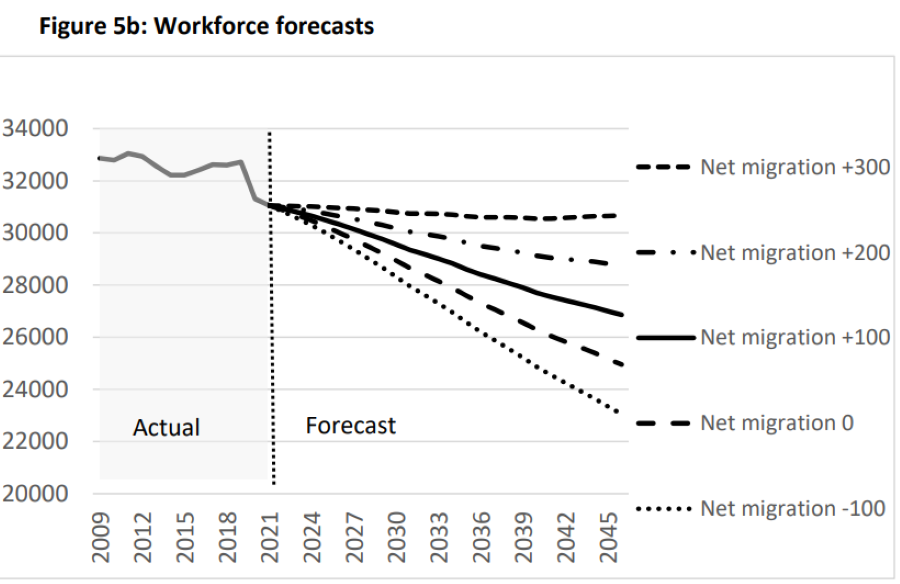
Pictured: This chart, published by the Committee, indicates how different levels of net inward migration alter the size of the island's workforce.
Deputy Roffey’s alternative plan included aiming for net inward migration of 200 people per year rather than 300 people per year.
The Committee estimated that this would slightly increase the island's population over the next 20 years - from around 64,000 to 65,000 - before a gradual reduction back to around 64,000 by the year 2051.
"While the correlation between the States' aspiration in respect of net migration and what actually happens in this regard may be very weak, it remains important for States' policy to reflect what the Assembly regards as desirable," said Deputy Roffey.
"The policy in the [Committee for Home Affairs'] policy letter, if realised, would lead to a very significant increase in Guernsey’s population, leading to large infrastructure challenges. These include...an aggravation of existing housing and traffic issues.
"By contrast, the policy suggested in this amendment would lead to very little increase in Guernsey’s population – roughly static over the timescale referred to.
"Maintaining the size of Guernsey’s workforce should be achieved through a combination of an annual +200 net migration, plus measures to optimise the economic participation and productivity of the resident population."
But his amendment was defeated by 11 votes to 22. In addition to Deputy Roffey himself, the 10 members who voted for a lower level of net inward migration were Deputies Cameron, De Sausmarez, Fairclough, Gabriel, Kazantseva-Miller, Le Tissier, Leadbeater, Meerveld, Soulsby and Taylor.

Pictured: Deputy Peter Roffey said he feared how the island's infrastructure, such as housing, would cope with higher levels of inward migration and a projected increase of around 7% in the total size of the population.
The States also backed other proposals from the Committee which will support the new headline population policy.
These include a plan for more jobs to attract short-term employment permits for workers from around the world. And scrapping five-year employment permits in favour of issuing more long-term employment permits which allow people to remain in the island indefinitely.
Although the States overwhelmingly backed the Committee’s policy letter, they also supported three amendments laid by other deputies.
The Committee for the Environment & Infrastructure was directed to report to the States on the investment necessary in the island’s infrastructure to support population growth.
The Policy & Resources Committee was directed to coordinate an investigation into increasing the proportion of local residents in the workforce and boosting their economic output.
And the Policy & Resources Committee and Committee for Health & Social Care were directed to investigate whether private health insurance should be made compulsory to limit the States’ healthcare costs as the size of the population increases.
The States also agreed that their successors in the next Assembly should review the island's population policies.
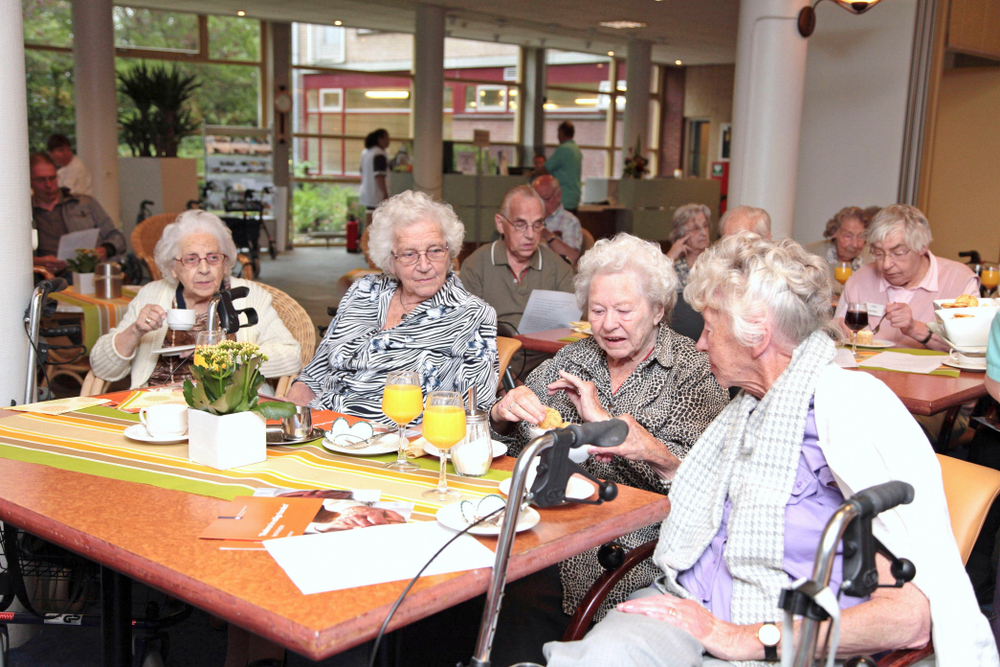
Pictured: The States have changed their population policy in response to changes in the demographic profile of the island - specifically an increase in the proportion of elderly people.
The Committee’s policy letter advised against seeing population growth as a way of avoiding tax increases to fill the States' projected annual shortfall of up to £85million a year.
"Allowing for both the impact on revenue and expenditure of a larger population, high-level initial analysis has found that +300 [net inward migration] may only reduce the net revenue requirement by between £14m and £23m per year by 2040," said the Committee.
"This is a relatively modest sum and highlights the fact that maintaining the size of the workforce, on its own, will not suffice in responding to the island’s financial needs."
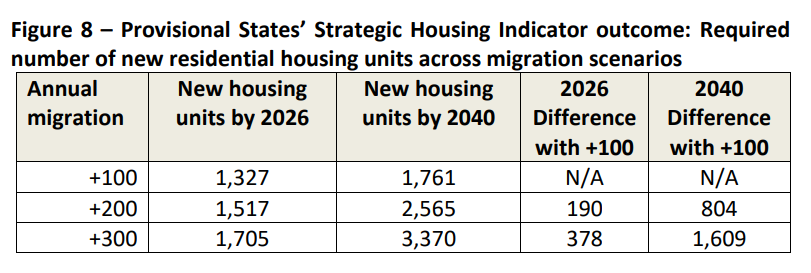
Pictured: This chart, published by the Committee, indicates how different levels of net inward migration alter the demand for new housing units in the short term and long term.
The States estimate that their new population policy could nearly double the number of additional housing units required in the next 20 years.
They forecast that maintaining net inward migration at an average of 100 people per year – the level experienced over the past 12 years – would require 1,760 new housing units by 2040.
But their revised assumption that net inward migration will be boosted to an average of 300 per year will require an estimated 3,370 new housing units by 2040.
For (22): Deputies Aldwell, Blin, Brouard, De Lisle, Dyke, Fairclough, Ferbrache, Gollop, Haskins, Helyar, Inder, Kazantseva-Miller, Mahoney, Matthews, McKenna, Moakes, Murray, Oliver, Parkinson, Prow, St. Pier and Vermeulen.
Against (9): Deputies Cameron, De Sausmarez, Gabriel, Le Tissier, Leadbeater, Queripel, Roffey, Soulsby and Taylor.
Abstained (2): Alderney Representatives Roberts and Snowdon.
Did not vote (1): Deputy Burford.
Absent (6): Deputies Bury, Dudley-Owen, Falla, Le Tocq, Meerveld and Trott.
Increased population could demand compulsory health insurance
Additional role won't be added to employment list
Less need for population growth if more local residents worked
3,000+ new housing units needed if deputies back population growth
Population growth plan faces challenge in States next week
P&R has "no agreed position" on key population growth plan
Home Affairs plan for more immigration to boost workforce
Highest number of over 65s since records began
Population review to consider "changing economic needs" after covid
Comments
Comments on this story express the views of the commentator only, not Bailiwick Publishing. We are unable to guarantee the accuracy of any of those comments.